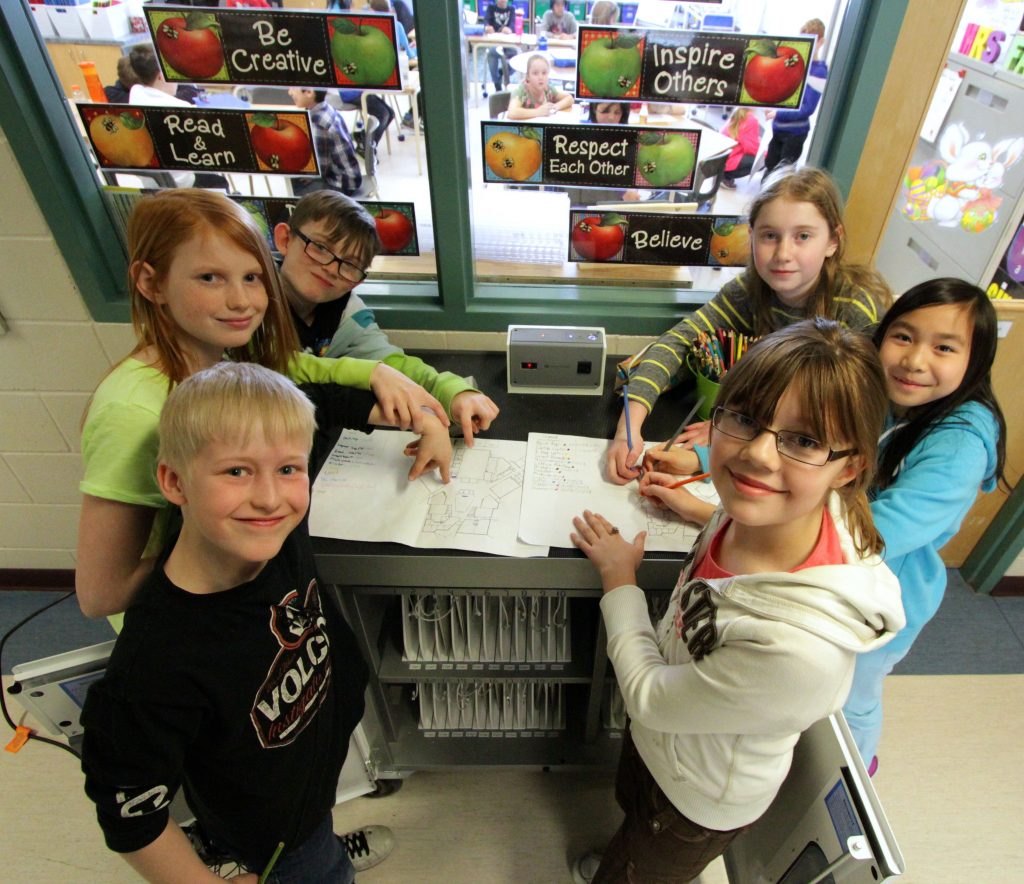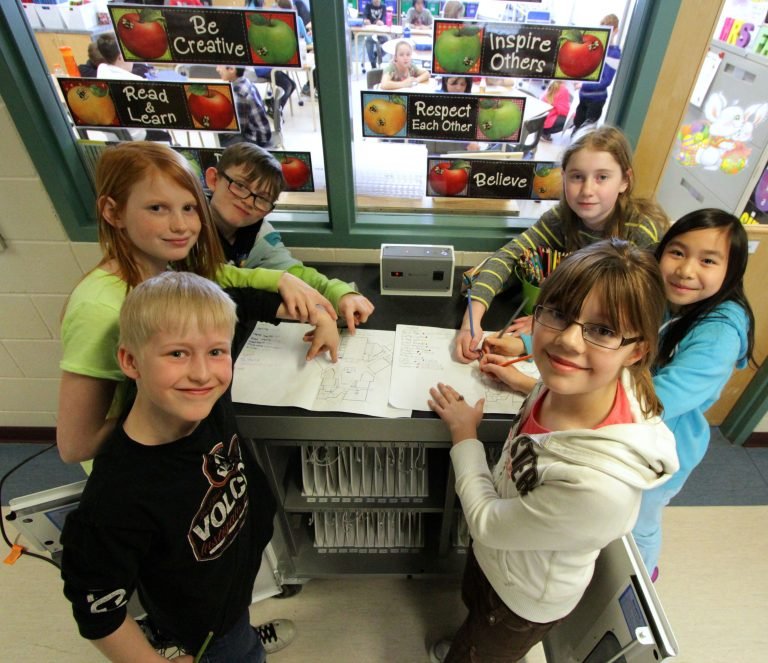By David Dodge and Duncan Kinney
“To the coffee machine” says Luke, a grade 5 student at Prairie Waters Elementary School in Chestermere, Alberta as he and a team of six students head into the teacher’s staff room.
“We’ll be discovering the phantom power of the coffee maker,” says Zane as Luke leaps up on the counter to unplug the teacher’s coffee pot and plug it into his portable Kill-a-Watt meter that measures energy consumption.
“$69 dollars a year for not using it. Wow,” says Zane.
These intrepid energy detectives are in Christine Van Den Eynden’s Grade 5 class and they were participating in the Phantom of the Classroom activity in the Classroom Energy Diet Challenge. Zane led a group of students all over the school searching for and documenting phantom loads, devices that are plugged in and constantly drawing power despite the fact that they’re not doing anything.
The students found printers, idle computers, electric staplers, computer charging stations, and a host of devices some of which where using energy while sitting idle.
Zeroing in on the electric stapler Zane says: “So what we could do to solve this problem is instead of doing an electric stapler we could just a regular stapler that you just click to use our energy instead of wasting other energy.”
“Let’s head back to our class to see, because I know there’s a huge powerbar and it’s overplugged and I think there’s a huge phantom there.”

Students from Ms Van Den Eynden’s grade 5 class at Prairie Waters elementary school in Chestermere Alberta find a phantom load at the school
Van Den Eynden’s class has participated in the Classroom Energy Diet Challenge for the past three years and she loves it. This year her grade 5 students have completed 18 of the 25 challenges so far (Full disclosure: The Classroom Energy Diet Challenge is offered by Canadian Geographic and sponsored by Shell Canada which also sponsors Green Energy Futures).
But these deceptively simply activities engage the students in real life issues and inspire them not only to learn more, but to share what they learn with their classmates, their families and their community. The class even has its own Twitter account.
The day we visited the school, the Grade 5s were putting on a school wide energy fair where they showed off their research on the various kinds of renewable energy that are used in Canada.
Standing at her display, Grade 5 student Caileigh who looked into hydropower said. “I never knew electricity could be made by water… I learned that most of Canada actually uses hydropower. Actually 80 per cent of Canada uses hydropower. The other 20 per cent of Canada, which is us, we use coal and coal is bad because it’s unrenewable.”
Three other young ladies took on biomass and shared their insights with us in rapid-fire succession: “I think it’s really interesting how you can turn wheat and crops into energy,” said Lauren.
“We really wanted to figure out how you could turn something ordinary into electricity that could power a house, a whole house,” said Keelin.
“And it’s neat because it’s all made from natural things, there is nothing man made there. It’s just all natural crops and wood chips,” said Miranda.
They rattled off the disadvantages as well. The large land area required and the costs to transport it, but these girls were smart. They even saw the value in co-generation and composting the left over waste.
“And it’s good because it can heat your home and make electricity. So instead of using two types [of energy] which can cost you double the money you can use less money from using the biomass,” said Miranda.
When you check out the presentations the kids are making, they’re taking on complex subjects with aplomb. “They’re having no trouble, You think it’s advanced concepts, but I think if you give the information to the students they’ll do with it what they need to do with it and they actually take in more that we give them credit for. I think they’re a little bit more educated than most adults out there right now,” says Van Den Eynden.
Van Den Eynden’s favourite activity so far is called Track Your Trash. Her students went around the school collecting the garbage. Then they sorted it into categories like uneaten food (which can be composted), recyclables and packaging. The amount of uneaten food that was thrown away shocked the kids, especially having just discovered the carbon footprint of processed food in a previous challenge.
Students in more than 1,200 classrooms all over Canada are participating in the challenge and increasing their energy literacy. There are $40,000 worth of prizes for classes who complete the challenges and score the most points. Van Den Eynden’s class scored 273 points and won $2,000 in this year’s Energy Diet Challenge.
And while prizes are nice, Van Den Eynden is excited to see a new generation helping us all become more sustainable.
“I think it’s important because this generation we’re finally realizing how important it is to be sustainable in what we do and I think it’s important to teach these guys at a young age so that they are able to make good decisions and take action and maybe change the direction where we’re going.”


